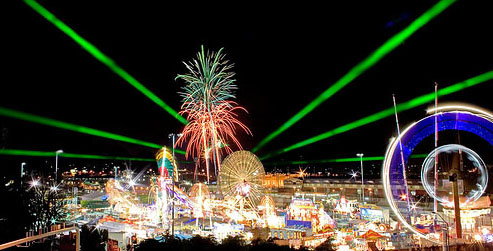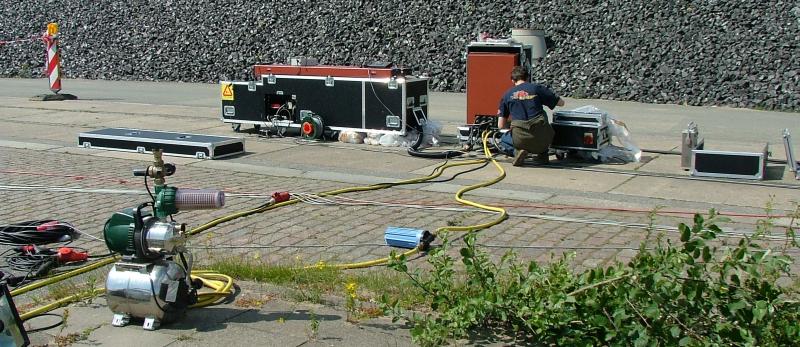Free Laser Shows bring thousands of visitors to downtown's High Falls District for a night of family entertainment.
Over a thousand of her ardent admirers showed up to raise a toast. At the end of a spectacular evening complete with Fireworks and a laser show, everybody present agreed that she was by far the fairest of them all… and yes - that she'd never looked better
 |
The Fireworks Display was a treat to every eye, it was fantastic and fabulous colour combinations and the pyrotechnic displays were excellent." |
It’s the event you won’t want to miss, a thunderous, booming, show closing spectacular that paints the night sky above the Showground in a rainbow of colours. Watch exploding stars, columns of light, lightning flashes and twinkling galaxies, choreographed by the legendary Grossfeuerwerke Prinz GmbH, who have more than 80 years experience in the big bang theory.
Prepares for the night. Large Frame Ion Laser System:

One Coherent INNOVA 100 25Watt green and blue single line powers for Argon lasers are specified at 514.5 and 488.0 nm only. One Coherent INNOVA 100 5Watt for red Krypton lasers the specified lines are 676.4 nm and 647.1 nm.
 |
Once the firework and Laser are in position, electrical cables and water hoses are connected to the van and control cables are connected between the van and the Laser and lighting. The Fireworks and Pyrotechnics are prepared and setup along with Laser, Lighting and Sound equipment. Between 6 to 10 houre may be required to setup including a rehearsal on the eve of the event.

 |
|
Here are some other factors to consider when you add lasers to your production.
All of these should be very familiar to a laser show company. These factors are mentioned here so you have an idea of what to expect.
Beam direction: For beams, the laser equipment is usually positioned in front of the audience. Beams will be aimed over their heads.
This is because laser beams appear brightest when they come straight towards you (the light scatters forward when it hits dust and smoke particles). They appear second-brightest when they come from straight behind you, and least bright when they are crossing your field of vision. Graphics screen: For graphics, rear-projection is generally preferred over front-projection. The images seem a bit more "magic” because the audience does not see the beams that create the graphics.
The graphics projector should be no closer than the largest dimension of the screen area. For example, if projecting onto a 20m x 30m screen, the laser should be no closer than 30m. The farthest distance is roughly 100m. These dimensions can vary if lenses are used for wide-angle or beam sharpening. They can also vary depending on how close the audience is to the screen. |
Equipment positioning: Direct-feed projectors join the laser and scanners as a single "laser projector" unit. These may be compact enough that the entire projector can be mounted on a stand or flown in the rigging. Fiber-fed projectors (where a fiber-optic cable brings laser light to a remote scan head) have even more flexibility in positioning. They can be put on a stand or flown. One hundred feet is a typical distance for the cable run. Because the fiber-optic cable is delicate it must be prevented from being run over, severely bent, kinked, etc.
Control positioning and setup time: Lasers require roughly the same setup time and control console space requirements as lighting and audio.
The control console location should allow the laser operator to see the audience. If this is not possible, a laser safety observer must be in front, with a headset or walkie-talkie for immediate communication with the laser operator.
Safety regulations: As listed below, both the show and the projector must comply with generally recognized laser safety requirements as well as government laws. In the U.S., this means compliance with federal laws and having a valid variance. Some states and localities may also have requirements. If lasers are used outdoors, then the appropriate aviation authority (FAA in the U.S., CAA in the U.K.) must be notified. In the U.S. this is required even if the beams are terminated on nearby buildings. The aviation authority will review the show and (hopefully!) will issue a letter of non-objection to the show performance.
The laser show company must take care of these reporting requirements. They cannot be put off onto the producer or venue (For fixed installations, the venue may be the variance holder but almost always it is the laser show company which handles the application process.)
Ceiling heights: In the U.S., normally the beam is required to be 3 meters (10 feet) above where the audience could stand, and 2.5 meters (8 feet) laterally from where the audience could reach sideways. In practical terms, this means the venue ceiling must be a minimum 12 feet high (giving a foot or so for the beam effects). It also means that if a projection is coming from behind the audience, towards a screen, the beam must always be at least 10 feet above the floor where the audience is seated.
Reflective surfaces: Many facilities have reflective surfaces such as mirror strips and chandeliers. Other reflective surfaces may be present, such as mirrors on intelligent lights and silver truss. If the laser projection could bounce off these surfaces, into audience areas, then the beam must be masked to prevent any stray audience reflections.
Safety setup: Time should be built into the production schedule for aiming and fine-tuning the laser projections. There should be no one in the laser areas except the laser company’s technicians. A good time for setup is when the other crews are taking a meal break, or after they have finished their calls.
Communications: Ideally, each person manning a laser location will be on headset. If this is not possible, then the operator at the main laser controls must be on headset with the producer; the other laser technicians can be on walkie-talkies with the laser operator.
Interfacing with audio: I take their audio from the main production; SMPTE or other methods are used for sync. Other laser companies provide their own audio which is fed (as a line-level signal) to the main mixer.
Interfacing with lighting: Lights should be off, or as low as possible during the show. I prefer to add some complementary lighting, such as a low red wash when green lasers are used. This is usually done with existing fixtures, simply by coordinating with the lighting director.
Video projectors should be masked or turned off to prevent video "gray” from illuminating screens.

